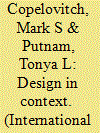| Srl | Item |
| 1 |
ID:
131512


|
|
|
|
|
| Publication |
2014.
|
| Summary/Abstract |
This research note highlights an important element missing from rational design theories of international agreements: "institutional context"-the presence or absence of existing and prior agreements between prospective partners in "new" cooperation. If, as rational design theorists argue, agreement design is deliberate, strategic, and directed toward enhancing contracting parties' ability to credibly commit to future cooperation, then prior design "successes" should influence the terms of additional cooperation. We test for this omitted variable problem in three agreement design outcomes: ex ante limitations on agreement duration, exit clauses, and dispute-settlement provisions. Through an augmentation and reanalysis of data from a key study in the rational design literature-Barbara Koremenos's "Contracting Around International Uncertainty"-we show institutional context is positively correlated with inclusion of ex ante time limitations in negotiated agreements and negatively correlated with the inclusion of exit clauses and third-party dispute-settlement provisions. Institutional context also mediates and conditions the effects of the explanatory variable at the heart of existing rational design theories-uncertainty about the future distribution of gains from cooperation. Our findings show that the collective appeal of particular design features varies not only with the nature of underlying strategic problems, but also with degrees of shared institutional context.
|
|
|
|
|
|
|
|
|
|
|
|
|
|
|
|
| 2 |
ID:
184112


|
|
|
|
|
| Summary/Abstract |
Export controls of dual-use products and sanctions on respective items are highly regulated in the European Union (EU). However, we find multiple instances of implementation and application problems of dual-use control in the Member States. To explain this puzzling observation, we investigate the relationship between the institutional design of sanctions and their subsequent implementation and application. Drawing on rational design theory, we argue that even if coherence is the EU’s stated goal, the institutional design of the current dual-use export control regime is inadequate to provide for coherence. National licensing decisions and a constant need for the interpretation of contingent rules in the implementation and application of dual-use sanctions are structural challenges to establish a coherent European policy. The relationship between institutional design and coherence, which we investigate in the context of sanctions, is not specific to the EU. Instead, we offer a novel conceptual and analytical tool to study the expected degree and causes of (in-)coherence in the implementation and application of any regime of international sanctions.
|
|
|
|
|
|
|
|
|
|
|
|
|
|
|
|